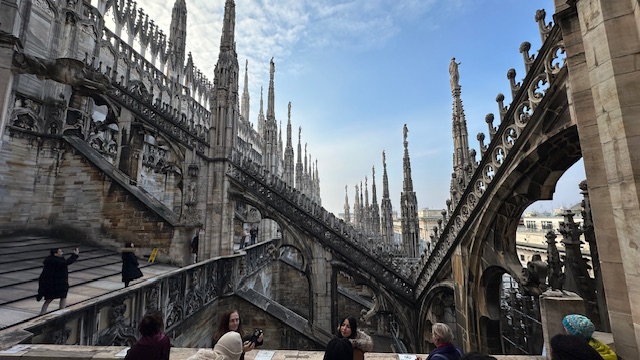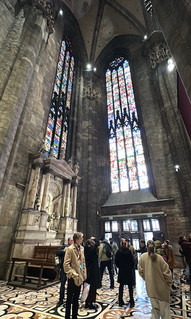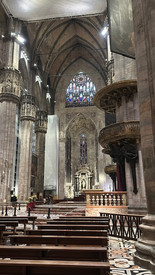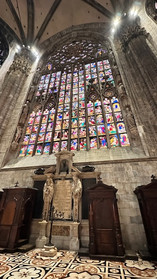Milano Cathedral – Duomo di Milano
- Maria Scuor
- Dec 18, 2024
- 15 min read
Italiano sotto ogni sezione
Gianni and I have been trying to visit the Milan Cathedral or Duomo di Milano since we have been married. It truly was very high on our list of must-see places and today we finally had the opportunity to book a tour and get a close-up view.
The duomo is dedicated to The Nativity of St. Mary or refers to a Christian feast day celebrating the birth of Mary, mother of Jesus. The duomo is also the seat of the Archbishop of Milan and interesting fact is that it took almost six centuries to complete it. It is the largest church in the Republic of Italy, this doesn’t include St. Peter’s Basilica or the Vatican, because it is in the State of Vatican City and not in the Republic of Italy.
Originally this site was an “episcopal complex” which included “the basilica nova (new basilica)” dedicated to Santa Tecla, the baptistery dedicated to San Giovanni alle Fonti, the “basilica vetus or basilica minor” of Santa Maria Maggiore and baptistery of Santo Stefano alle Fonti. The presence of two basilicas very close together was in fact common in Northern Italy during the Constantinian era and could be found in cities with episcopal seats. The remains of these buildings are visible in the Archaeological Area underneath the duomo.
Fire destroyed these buildings in 1075 and in 1386 Archbishop Antonio da Saluzzo began construction of the new duomo. With his cousin Gian Galeazzo Visconti, who had just become the first Duke of Milan, they collected large sums of donations to build the duomo. It was meant to reward the noble and the working classes who had suffered under the tyrannical Visconti predecessor, Barnabò.
To accommodate the new duomo, many buildings were demolished and the stones of the old church of Santa Maria Maggiore were used for the new duomo. Under the strict guidance of the “Fabbrica del Duomo”, the organization that was established to supervise the construction, 300 employees were led by the first engineer Simone da Orsenigo.
However, Visconti didn’t want a Lombard Gothic style church and in 1389 he appointed engineer, Nicolas de Bonaventure of France to design it in Rayonnant Gothic style and gave the Fabbrica del Duomo exclusive use of the marble from the Candoglia quarry and exempted it from taxes. Canals had to be dug up and filled to bring the marble from the quarries to the construction site.
By the time Gian Galeazzo Visconti died in 1402, almost half of the duomo was built. But construction almost stalled until 1480 because of lack of money and ideas. It wasn’t until 1510 that the octagonal cupola was completed under Duke Ludovico Sforza. Work continued on the inside of the duomo with new altars and baptistry were added between 1575 and 1585. At the time Carlo Borromeo became Archbishop and in 1577 he consecrated the new church.
By the 17th century Archbishop Federico Borromeo had the foundations of the new façade laid and work continued on five portals and two middle windows. In 1762 the Madonnina's spire, was erected at the height of 108.5 m and has the famous Madonnina Statue at the very top. This Madonnina is the protector and in 1930s a law prohibited any building exceeding the height of the Madonnina. But when the first skyscraper was built, a new tradition began. When a building exceeds 108.5 meters in height, a scale replica of the Madonnina is placed on its roof, ensuring that the city’s protector is always at the highest point.
.
It wasn’t until 1805 that Napoleon the about to be crowned King of Italy, ordered the façade to be finished. He had it funded by the French treasurer and within seven years it was completed. A statue of Napoleon was added on top of one of the spires and he was crowned King of Italy at the Duomo.
In the following years, most of the missing arches and spires were constructed and statues finished. Between 1829–1858, new stained-glass windows replaced the old ones and the last details of the duomo were completed in the 20th century, with the last portal inaugurated on January 6, 1965. This was the day considered as the end of the process, even though some uncarved blocks remain to be completed as statues. Like many other churches in cities bombed by the Allied forces, the Duomo suffered some damage, although to a lesser degree compared to other major buildings in the area.
The Duomo's main façade went under renovation from 2003 to February 2009. When it was done, the colours of the Candoglia marble were once again beautiful. The roof is open to tourists and we were able to see the incredible statues, pinnacle, spires and flying buttresses as well as the golden Madonnina statue perched high above the duomo.
They say there are 3,400 statues, 135 gargoyles and 700 figures that decorate the duomo. This includes a small head statue of Abraham Lincoln that we got to see on the rooftop. If you ever go to Milan, either climbing 256 stairs or taking the elevator up, you will see incredible architecture and stunning views of Milan.
It took thousands of artists, sculptors and specialized workers to construct this amazing duomo. Architects from across Europe were invited to work on the project (at least 78 different architects total) and as it grew and grew, its construction dragged on over the years but totally worth the efforts that everyone put in.
Here is a TikTok video and photos of the exterior of the duomo - Ecco un video TikTok e le foto dell'esterno del duomo
Io e Gianni abbiamo cercato di visitare il Duomo di Milano da quando ci siamo sposati. Era davvero in cima alla nostra lista di luoghi da non perdere e oggi abbiamo finalmente avuto l'opportunità di prenotare un tour e avere una vista ravvicinata.
Il duomo è dedicato alla Natività di Santa Maria o si riferisce a una festa cristiana che celebra la nascita di Maria, madre di Gesù. Il duomo è anche la sede dell'Arcivescovo di Milano e il fatto interessante è che ci sono voluti quasi sei secoli per completarlo. È la chiesa più grande della Repubblica Italiana, senza contare la Basilica di San Pietro o il Vaticano, perché si trova nello Stato della Città del Vaticano e non nella Repubblica Italiana.
In origine questo sito era un "complesso vescovile" che comprendeva "la basilica nova" dedicata a Santa Tecla, il battistero dedicato a San Giovanni alle Fonti, la "basilica vetus o basilica minore" di Santa Maria Maggiore e il battistero di Santo Stefano alle Fonti. La presenza di due basiliche molto vicine tra loro era infatti comune nell'Italia settentrionale durante l'epoca costantiniana e si poteva trovare nelle città con sedi vescovili. I resti di questi edifici sono visibili nell'Area Archeologica sottostante il Duomo.
Un incendio distrusse questi edifici nel 1075 e nel 1386 l'arcivescovo Antonio da Saluzzo iniziò la costruzione del nuovo duomo. Con il cugino Gian Galeazzo Visconti, appena diventato primo duca di Milano, raccolsero ingenti somme di donazioni per costruire il duomo. Aveva lo scopo di premiare i nobili e le classi popolari che avevano sofferto sotto il tirannico predecessore visconteo, Barnabò.
Per ospitare il nuovo duomo, molti edifici furono demoliti e le pietre della vecchia chiesa di Santa Maria Maggiore furono utilizzate per il nuovo duomo. Sotto la stretta guida della "Fabbrica del Duomo", l'organizzazione che fu istituita per supervisionare la costruzione, 300 dipendenti furono guidati dal primo ingegnere Simone da Orsenigo.
Tuttavia, Visconti non voleva una chiesa in stile gotico lombardo e nel 1389 incaricò l'ingegnere Nicolas de Bonaventure di Francia di progettarla in stile gotico rayonnant e ha concesse alla Fabbrica del Duomo l'uso esclusivo del marmo proveniente dalla cava di Candoglia e lo esentò dalle tasse. I canali dovevano essere scavati e riempiti per portare il marmo dalle cave al cantiere.
Quando Gian Galeazzo Visconti morì nel 1402, quasi la metà del duomo era stata costruita. Ma la costruzione fu quasi bloccata fino al 1480 a causa della mancanza di denaro e di idee. Solo nel 1510 la cupola ottagonale fu completata sotto il duca Ludovico Sforza. I lavori proseguirono all'interno del duomo con l'aggiunta di nuovi altari e battistero tra il 1575 e il 1585. All'epoca Carlo Borromeo divenne arcivescovo e nel 1577 consacrò la nuova chiesa.
Nel XVII secolo l'arcivescovo Federico Borromeo fece gettare le fondamenta della nuova facciata e proseguirono i lavori per cinque portali e due finestre centrali. Nel 1762 fu eretta la guglia della Madonnina, alta 108,5 m, che presenta la famosa Statua della Madonnina. Questa Madonnina ne è la protettrice e negli anni '30 una legge vietò qualsiasi costruzione che superasse l'altezza della Madonnina. Ma quando fu costruito il primo grattacielo, iniziò una nuova tradizione. Quando un edificio supera i 108,5 metri di altezza, sul suo tetto viene posizionata una replica in scala della Madonnina, facendo in modo che il protettore della città sia sempre nel punto più alto.
Fu solo nel 1805 che Napoleone, in procinto di essere incoronato Re d'Italia, ordinò che la facciata fosse terminata. Lo fece finanziare dal tesoriere francese e nel giro di sette anni fu completato. Una statua di Napoleone fu aggiunta in cima a una delle guglie e fu incoronato re d'Italia in Duomo.
Negli anni successivi, la maggior parte degli archi e delle guglie mancanti furono costruiti e le statue terminate. Tra il 1829 e il 1858, nuove vetrate sostituirono quelle vecchie e gli ultimi dettagli del duomo furono completati nel XX secolo, con l'ultimo portale inaugurato il 6 gennaio 1965. Questo è stato il giorno considerato come la fine del processo, anche se alcuni blocchi non scolpiti devono ancora essere completati come statue. Come molte altre chiese nelle città bombardate dalle forze alleate, il Duomo subì alcuni danni, anche se in misura minore rispetto ad altri importanti edifici della zona.
La facciata principale del Duomo è stata oggetto di ristrutturazione dal 2003 al febbraio 2009. Al termine, i colori del marmo di Candoglia erano tornati ad essere belli. Il tetto è aperto ai turisti e siamo stati in grado di vedere le incredibili statue, il pinnacolo, le guglie e gli archi rampanti, nonché la statua dorata della Madonnina arroccata sopra il duomo.
Si dice che ci siano 3.400 statue, 135 gargoyle e 700 figure che decorano il duomo. Questo include una piccola statua di Abraham Lincoln che abbiamo avuto modo di vedere sul tetto. Se mai andrete a Milano, salendo 256 gradini o prendendo l'ascensore, vedrete un'architettura incredibile e una vista mozzafiato di Milano.
Ci sono voluti migliaia di artisti, scultori e operai specializzati per costruire questo straordinario duomo. Architetti provenienti da tutta Europa sono stati invitati a lavorare al progetto (almeno 78 architetti diversi in totale) e man mano che cresceva, la sua costruzione si è trascinata nel corso degli anni, ma ne è valsa la pena.
INTERIOR
The duomo has five naves, including the wings, that are divided by rows of 40 pillars measuring 78 feet in height and 8 feet in diameter. The pillars are made of solid brick and covered with marble. The pillars are decorated with statues, circles of smaller statues and embellishments. The pillars are fused at the top of the cathedral's ethereal groin vaults that are lined with ornate carvings.
The floor of the duomo is made up of gray-pink Candoglia marble slabs that are inlaid together with Arzo red and black Vannera marble from Lake Como to form unbelievable floral motifs. This design covers the whole floor space of the duomo.
The central nave leads into a beautiful presbytery which is divided into a raised semi-circle surrounded by 10 pillars with a high altar in the middle made of a solid block of brocatelle marble. This altar was from the Santa Maria Maggiore Basilica.
Beneath the high altar is a crypt called the Jemale Chapel of the Duomo and contains sacred relics of Saint Charles Borromeo. It dates back to the 16th century and its dome-like ceiling is embellished with stucco engravings depicting the Passion of Christ and the Eucharist.
A very cool feature is the white strip that crosses the entire width of the building with a brass line in the center. This is a sundial, constructed in 1786. There is a gnomon hole carved into the ceiling and a fine ray of light enters and strikes the brass line indicating the solar noon. On either side of the brass line are small white slabs printed with Zodiac signs to tell the season of the year.
The original organs date back to 1394 but these were replaced in 1938, when Benito Mussolini decided to donate a new organ to the duomo. Italian organ-building firms Mascioni and T amburini created what is today the largest instrument in Italy, second in Europe and seventh in the world. Over the years, various interventions occurred that improved the artistic qualities and technical characteristics.
There are 15,800 pipes with the tallest being 9 metres and the smallest a few centimetres. Two cases that date back to the 16th century organs and two modern cases made in 1986. Two twin consoles with 5 keyboards and 211 sound registers. It is ornate with detailed carvings and encasings for the organ pipes. Through many restorations, the organ was transformed from a mechanical to an electrically operated instrument.
To the left of the altar is the 1562 statue of Saint Bartholomew Flayed. It is one of the most prominent statues in the duomo and is known for its grim design. It is an almost life-size statue of St. Bartholomew. According to tradition, he was a disciple of Jesus, and was flayed alive.
Therefore, the statue shows his raw flesh and muscle and the garment wrapped around his shoulder is not a garment, but his skin.
What was amazing to me were the stained-glass windows. There are 55 with some from the 14th century and some as young as the 1988. The figures within the glass represent stories from the Old and New Testaments, as well as the Apocalypse. In ancient time, even if you couldn’t read, you could learn about the history of salvation by looking at the figures within the stained-glass.
Here is a TikTok video and photos of the interior of the duomo - Ecco un video TikTok e le foto degli interni del duomo
INTERNO
Il duomo ha cinque navate, comprese le ali, che sono divise da file di 40 pilastri che misurano 24 m di altezza e 2,5 m di diametro. I pilastri sono realizzati in mattoni pieni e rivestiti in marmo. I pilastri sono decorati con statue, cerchi di statue più piccole e abbellimenti. I pilastri sono fusi nella parte superiore delle eteree volte a crociera della cattedrale che sono fiancheggiate da intagli decorati.
Il pavimento del duomo è costituito da lastre di marmo di Candoglia grigio-rosa che sono intarsiate insieme al marmo rosso Arzo e al marmo nero Vannera del Lago di Como per formare incredibili motivi floreali. Questo disegno copre l'intera superficie del duomo.
Dalla navata centrale si accede ad un bel presbiterio che si articola in un semicerchio rialzato circondato da 10 pilastri con al centro un altare maggiore realizzato in un blocco pieno di marmo broccatello. Questo altare proviene dalla Basilica di Santa Maria Maggiore.
Sotto l'altare maggiore si trova una cripta chiamata Cappella Jemale del Duomo e contiene le sacre reliquie di San Carlo Borromeo. Risale al XVI secolo e il suo soffitto a cupola è impreziosito da incisioni in stucco raffiguranti la Passione di Cristo e l'Eucaristia.
Una caratteristica molto interessante è la striscia bianca che attraversa l'intera larghezza dell'edificio con una linea di ottone al centro. Si tratta di una meridiana, costruita nel 1786. C'è un foro per gli gnomoni scavato nel soffitto e un sottile raggio di luce entra e colpisce la linea di ottone che indica il mezzogiorno solare. Ai lati della linea di ottone ci sono piccole lastre bianche stampate con segni zodiacali per raccontare la stagione dell'anno.
Gli organi originali risalgono al 1394 ma furono sostituiti nel 1938, quando Benito Mussolini decise di donare un nuovo organo al duomo. Le ditte organarie italiane Mascioni e Tamburini hanno dato vita a quello che oggi è il più grande strumento in Italia, secondo in Europa e settimo nel mondo. Nel corso degli anni si sono verificati vari interventi che ne hanno migliorato le qualità artistiche e le caratteristiche tecniche.
Ci sono 15.800 tubi, il più alto dei quali è di 9 metri e il più piccolo di pochi centimetri. Due casse che risalgono agli organi del XVI secolo e due custodie moderne realizzate nel 1986. Due console gemelle con 5 tastiere e 211 registri sonori. È decorato con intagli dettagliati e involucri per le canne d'organo. Attraverso numerosi restauri, l'organo è stato trasformato da uno strumento meccanico a uno ad azionamento elettrico.
A sinistra dell'altare si trova la statua di San Bartolomeo Scorticato del 1562. È una delle statue più importanti del duomo ed è nota per il suo design cupo. Si tratta di una statua di San Bartolomeo quasi a grandezza naturale. Secondo la tradizione, era un discepolo di Gesù e fu scorticato vivo.
Pertanto, la statua mostra la sua carne e i suoi muscoli crudi e l'indumento avvolto intorno alla sua spalla non è un indumento, ma la sua pelle.
Ciò che mi ha stupito sono state le vetrate colorate. Ce ne sono 55, alcuni del 14° secolo e altri giovani come il 1988. Le figure all'interno del vetro rappresentano storie dell'Antico e del Nuovo Testamento, così come l'Apocalisse. Nell'antichità, anche se non si sapeva leggere, si poteva conoscere la storia della salvezza osservando le figure all'interno della vetrata.
Archaeological Area
We got to tour the archaeological area situated underneath the duomo. Here are remains of buildings of worship that date back to the period between the Roman Empire and the Middle Ages and were demolished to make room for the new duomo. Remains found were:
The Baptistery of San Giovanni alle Fonti built between 378 and 397 is one of the first baptisteries in Milan and dedicated to John the Baptist. Located in between the Santa Tecla and Santa Maria Maggiore Basilica, where Piazza del Duomo now stands. This was a baptistery for men only and the nearby baptistery of Santo Stefano alle Fonti was where women would be baptised. The font had an octagonal plan, with symbolic meaning explained by Saint Ambrose: "The seventh day of creation indicates the mystery of the law, the eighth that of the resurrection of Jesus and therefore of eternity". The baptistery was demolished in mid-May 1388, to make room for the new duomo.
The Basilica of Santa Tecla, originally named basilica nova was built in 350 and was the centre of many conflicts between the Trinitarian majority of the population and the Arian elite. In 386, the Arian bishop Mercurino Assenzio challenged the new Milanese bishop, Ambrose of Trier a supporter of Trinitarianism, who became Saint Ambrose, in a public debate. Ambrose took siege of the church and returned it to Catholic worship. Even thought construction of the duomo started in 1386, this building remained in use until 1458.
The cathedral of Santa Maria Maggiore Basilica, originally named basilica vetus, was one of the first churches in Milan and construction began in 314, a year after the Edict of Milan, which allowed citizens the freedom to honour their own deities. Reconstruction of the basilica vetus was carried out by bishop Angilberto I who changed the name to Cathedral Santa Maria Maggiore. It was consecrated as such by his successor Archbishop Angilberto II in 836. Demolition began in 1386 to make room for the new duomo.
The Baptistery of Santo Stefano alle Fonti was the oldest Christian building in the Lombard city and construction began in 313. In this baptistery, Saint Ambrose was baptized in 374. Once the Baptistery of San Giovanni alle Fonti was built to baptize men, this baptistery was used to baptize women. Demolition of this site began in 1386 to make room for the new duomo.
Here are photos of the Archaeological Area - Ecco le foto dell'Area Archeologica
Area Archeologica
Abbiamo avuto modo di visitare l'area archeologica situata sotto il duomo. Qui si trovano resti di edifici di culto che risalgono al periodo compreso tra l'Impero Romano e il Medioevo e che furono demoliti per far posto al nuovo duomo. I resti trovati furono:
Il Battistero di San Giovanni alle Fonti, costruito tra il 378 e il 397, è uno dei primi battisteri di Milano e dedicato a Giovanni Battista. Situato tra Santa Tecla e la Basilica di Santa Maria Maggiore, dove ora sorge Piazza del Duomo. Questo era un battistero per soli uomini e il vicino battistero di Santo Stefano alle Fonti era il luogo in cui venivano battezzate le donne. Il fonte battesimale aveva una pianta ottagonale, con un significato simbolico spiegato da sant'Ambrogio: "Il settimo giorno della creazione indica il mistero della legge, l'ottavo quello della risurrezione di Gesù e quindi dell'eternità". Il battistero fu demolito a metà maggio del 1388, per far posto al nuovo duomo.
La Basilica di Santa Tecla, originariamente chiamata basilica nova, fu costruita nel 350 e fu il centro di molti conflitti tra la maggioranza trinitaria della popolazione e l'élite ariana. Nel 386, il vescovo ariano Mercurino Assenzio sfidò in un dibattito pubblico il nuovo vescovo milanese, Ambrogio di Treviri, sostenitore del trinitarismo, che divenne sant'Ambrogio. Ambrogio prese l'assedio della chiesa e la restituì al culto cattolico. Anche se la costruzione del duomo iniziò nel 1386, questo edificio rimase in uso fino al 1458.
La basilica di Santa Maria Maggiore, originariamente chiamata basilica vetus, fu una delle prime chiese di Milano e la costruzione iniziò nel 314, un anno dopo l'Editto di Milano, che concedeva ai cittadini la libertà di onorare le proprie divinità. La ricostruzione della basilica vetus fu effettuata dal vescovo Angilberto I che cambiò il nome in Cattedrale di Santa Maria Maggiore. Fu consacrata come tale dal suo successore, l'arcivescovo Angilberto II, nell'836. Le demolizioni iniziarono nel 1386 per far posto al nuovo duomo.
Il Battistero di Santo Stefano alle Fonti fu il più antico edificio cristiano della città lombarda e la costruzione iniziò nel 313. In questo battistero fu battezzato sant'Ambrogio nel 374. Un tempo costruito il Battistero di San Giovanni alle Fonti per battezzare gli uomini, questo battistero serviva per battezzare le donne. La demolizione di questo sito iniziò nel 1386 per far posto al nuovo duomo.
I can’t say enough about how beautiful the Duomo di Milano. It truly is a magnificent work of art that captures your heart as soon as you get near it. The grandeur as well as the incredible architecture is something to be treasured.
Non posso che elogiare quanto sia bello il Duomo di Milano. È davvero una magnifica opera d'arte che ti cattura il cuore non appena ti avvicini. La grandiosità e l'incredibile architettura sono qualcosa di cui fare tesoro.































































































































































































































Commentaires